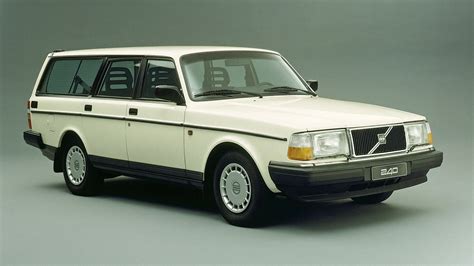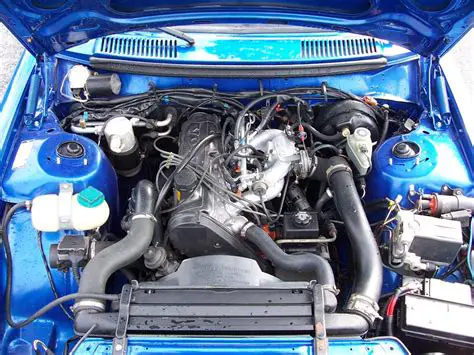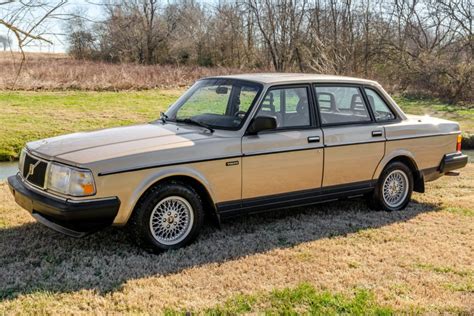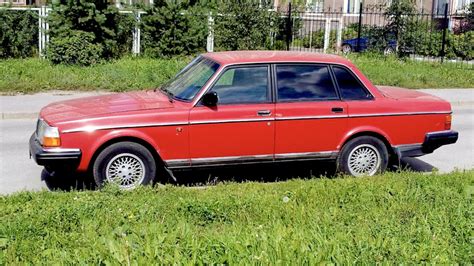1992 Volvo 240 problems

The Volvo 200 Series (or 240 and 260 Series) is a range of mid-size cars produced by Swedish company Volvo Cars from 1974 until 1993, with more than 2.8 million total units sold worldwide. Like the Volvo 140 Series (1966 to 1974), from which it was developed, it was designed by Jan Wilsgaard.
The series overlapped production of the Volvo 700 Series (1982 to 1992). As the 240 Series remained popular, only the 260 Series was displaced by the 700 Series, which Volvo marketed alongside the 240 for another decade. The 700 was replaced by the 900 Series in 1992, a year before the 240 was discontinued. Production of the 240 ended on 14 May 1993, after nearly 20 years, with the basic platform and architecture lasting 27 years, if the production run of the original 140 Series is aggregated.
History
The Volvo 240 and 260 series were introduced in the autumn of 1974, and was initially available as six variations of the 240 Series (242L, 242DL, 244DL, 244GL, 245L and 245DL) and two variations of the 260 Series (264DL and 264GL). The 240 Series was available as a sedan (with two or four doors) or a station wagon, however, the 260 Series was available as a coupé (262C Bertone), two-door sedan, four-door sedan, or station wagon. The 200 looked much like the earlier 140 and 164, they shared the same basic body shell and were largely identical from the cowl rearward. However, the 200 incorporated many of the features and design elements tried in the Volvo VESC ESV in 1972, which was a prototype experiment in car safety. The overall safety of the driver and passengers in the event of a crash was greatly improved with very large front and rear end crumple zones. Another main change was the new engines offered, which were of an overhead cam design based on the earlier B20. The 260 series also received a V6 engine in lieu of the 164's inline-six.
The 200 Series had MacPherson strut-type front suspension, which increased room around the engine bay, while the rear suspension was a modified version of that fitted to the 140 Series. The steering was greatly improved with the introduction of rack-and-pinion steering, with power steering fitted as standard to the 244GL, 264DL and 264GL, and there were some modifications made to the braking system (in particular the master cylinder).
The front end of the car was also completely restyled with a "shovel nose" which closely resembled that of the VESC prototype vehicle – that being the most obvious change which made the 200 Series distinguishable from the earlier 140 and 160 Series. Other than all the changes mentioned above, the 200 Series was almost identical to the 140 and 160 Series from the bulkhead to the very rear end. In 1978, a facelift meant a redesigned rear end for sedans, with wraparound taillights and a trunk opening with a lower lip. The dashboard was derived from the safety fascia introduced for the 1973 model year 100 Series - the main change for the 200 Series was the adoption of slatted "egg crate" style air vents in place of the eyeball style vents used in the 140/160 and the square clock. All models were available with a choice of four-speed manual or a three-speed automatic transmission. Overdrive was also optional on the manual 244GL, while a five-speed manual gearbox was optional on the 264GL and 265GL.
In the autumn of 1975 (for the 1976 model year in America), the 265 DL estate became available alongside the existing range, and this was the first production Volvo estate to be powered by a six-cylinder engine. The choice of gearboxes was also improved, with overdrive now available as an option in all manual models except the base-model 242L and 245L. As before, a three-speed automatic was optional in every model. The B21A engine gained three horsepower; a new steering wheel and gearknob were also introduced.
At the 1976 Paris Motor Show Bertone first showed the stretched 264 TE, a seven-seat limousine on a 3,430 mm (135.0 in) wheelbase, although it had entered production earlier. The raw bodies were sent from Sweden to Grugliasco for lengthening, reinforcing, and finishing. Carl XVI Gustav of Sweden used one, as did much of East Germany's political leadership.
For 1977 the B19A engine with 90 PS (66 kW) replaced the B20A in most markets, although the old pushrod type soldiered on for another two years in some places. This is also the year that the sportier 242 GT arrived.
In 1978 the grille was altered, now with a chrome surround. Rear view mirrors were now black, while the front seats were changed as were the emblems, while interval wipers were introduced. 1978 models were also the first 240s to receive a new paint formula, to help solve the severe rust problems in previous model years.
The 1979 model year brought a full facelift front and rear, the most obvious change being the adoption of flush fitting square headlamps on the DL or rectangular headlamps on the GL, GLE in place of the recessed circular units. The sedans received new wraparound rear lamp clusters and a restyled leading edge to the trunk lid, while the rear of the wagons remained unchanged. The GLE was added while the L was cancelled, and the six-cylinder diesel arrived late in the year. For 1980, the sporty GLT arrived, replacing the GT. For 1981 there was yet another new grille, while the station wagons received new, wraparound taillights. The B21A gained some four horsepower, now 106 PS (78 kW), while the carburetted B23A with 112 PS (82 kW) was introduced in some markets. The Turbo arrived, while six-cylinder models now had a more powerful 2.8-liter engine. 1981 also saw the dashboard altered significantly, which a much larger binnacle in order to bring the radio and clock within the driver's line of sight. The instrument pod itself, which had been unaltered since the 1973 model year 100 Series, was also redesigned.
Incremental improvements were made almost every year of the production run. One of the major improvements was the introduction of the oxygen sensor in North America in late 1976 (1977 models), which Volvo called Lambda Sond and developed in conjunction with Bosch. It added a feedback loop to the Jetronic fuel injection system already in use, which allowed fine-tuning of the air and fuel mixture and therefore produced superior emissions, drivability and fuel economy.
For the 1983 model year, Volvo dropped the DL and GLE labels, selling the cars simply as 240s. In the domestic Swedish market, the 240 could be had with a 2.1 or 2.3-liter engine (more options were available in export), but the bigger engine always came coupled with a five-speed transmission and tinted windows. The 1983s also received wider side trim and all models had the larger taillights introduced on the previous year's GLT model. A B23E-engined GLE variant was also added (not available with two doors). Buyers protested against the lack of grades and they returned for 1984. A new manual gearbox also arrived for 1984, while a four-speed automatic option was available in the GL. The GLT and Turbo versions received a taller grille.
While Volvo had been planning to discontinue the 200-series since the early 1980s, the design kept selling well and Volvo provided steady updates. In late 1991, for the 1992 model year, it received 160 detail improvements including changes to the heater controls, heated rear view mirrors, and revised front seats. For the final, 1993 model year, air conditioning units were upgraded to use R-134a rather than the ozone-depleting R-12 (Freon).
About one-third of all 240s sold were station wagons, which featured very large cargo space of 41 cubic feet (1.2 m3). They could be outfitted with a rear-facing foldable jumpseat in the passenger area, making the wagon a seven-passenger vehicle. The jumpseat came with three-point seat belts, and wagons were designed to have a reinforced floor section, protecting the occupants of the jumpseat in the event of a rear-end collision.
A 1993 Volvo 240DL was driven by IKEA founder Ingvar Kamprad, who stopped driving it when he was told the car was too dangerous due to outdated safety design two decades later.
The last 200 produced was a blue station wagon built to the Italian specification and named the "Polar Italia", currently displayed at the Volvo World Museum. It was manufactured the 14th May 1993.

Social links
Common 1992 Volvo 240 problems
The Volvo 240, produced between 1975 and 1993, is known for its robustness and durability, but like any other vehicle, it has common problems that owners often encounter. Here are some of the most frequently reported issues with the 1992 Volvo 240, based on complaints from owners:
- Flame Trap System: The flame trap system, used in Volvo models from 1976 to 1993, is designed to capture unused fuel vapors from the combustion chamber. However, this system has been problematic since its introduction, causing oil leaks and idle problems due to clogging over time.
- Worn Air Intake Hose & Air Box Thermostats: The large plastic accordion style intake hose that connects the air mass meter to the intake manifold can wear out over time, causing unfiltered and unmetered air to enter the engine. This can lead to erratic behavior and running lean. The air box thermostat, which routes hot air from the exhaust manifold to aid in cold start performance, can also fail, causing superheated air to be drawn into the engine, reducing performance and shortening the life of the air mass meter.
- Fuel Injection Relay: The main fuel pump relay can be a source of problems in 1978-1985 Volvo 240 models. Corrosion and electrolosis can affect the small contact area of European ceramic style fuses, leading to intermittent or no start issues.
- Motor & Transmission Mounts: The Volvo 240 goes through engine and transmission mounts on a regular basis due to its safety-related design that allows the engine to move back and under the car in the event of a serious head-on collision. These mounts should be inspected annually and replaced every 2-3 years, depending on driving habits.
- Lumbar Support Systems: The lumbar support systems in Volvo 240 seats, known for their comfort and adjustable back support, commonly fail between 50-100,000 miles. The bottom seat cushion support grid is also a weak spot, causing drivers to struggle when trying to see over the steering wheel when it fails.
- Odometer Failure: The odometer in the 240 is driven off of the main speedometer drive shaft by a small rubber gear, which can lose its teeth and grip on the driveshaft after 30 years or more, resulting in erratic or complete loss of odometer & tripometer function. The repair can be done by the average do-it-yourselfer in about a half hour using a repair kit.
- Main Fuses: The main fuse box in the Volvo 240 is located in the driver side kick panel and is susceptible to corrosion from water that can enter the interior and drip directly onto the fuses. Preventing corrosion and electrolosis can help avoid numerous problems associated with the fuse box.
- Heater Fan Motor: The heater blower motor in the Volvo 240 is buried deep in the dash and can take 3-4 hours for an experienced mechanic to replace. The motor is of decent quality, but if it fails, it can take all weekend for a beginner do-it-yourselfer to replace.
- Seat Grid: The bottom seat cushion support grid is a weak spot in Volvo 240 seats, causing drivers to struggle when trying to see over the steering wheel when it fails. This part was discontinued by Volvo a few years ago, but an improved version will be introduced this fall.
- Oil Leaks: Oil leaks are a common problem in the Volvo 240, often caused by worn-out or damaged seals and gaskets. Regular maintenance and inspections can help identify and address these issues before they become major problems.
These common problems with the 1992 Volvo 240, while not exhaustive, provide a general overview of the issues that owners may encounter. Regular maintenance, inspections, and timely repairs can help ensure the longevity and reliability of this classic vehicle.

Are old Volvo 240s reliable?
8 Robust And Ultra-Reliable
Being the first manufacturer to fit 999,999 mph odometers to its cars, Volvo was underlining its vehicle's potential for longevity, and thanks to many galvanized parts, excellent build quality, and almost bomb-proof mechanicals, the 240 continues to spin those digits.
How long will a Volvo 240 last?
I have several 240 customers with well over 300k miles and they still run like a brand new car. Most of their interiors have seen better days, as dash and console cracks, door panels coming apart etc are common fair. The drive train however, if taken care of even a little bit it will last a long, long time.
What engine came in a 1992 240 Turbo Volvo?
1992 Volvo 240 Specs, Features & Options
| 1 of 2 240 Sedan 4D | 2 of 2 240 GL Sedan 4D |
|---|---|
| See Pricing See Cars in Stock | See Pricing See Cars in Stock |
| 114 @ 5400 RPM | 114 @ 5400 RPM |
| Engine | |
| 4-Cyl, 2.3 Liter | 4-Cyl, 2.3 Liter |
Are Volvo 240 rare?
Globally, the Volvo 240 is far from a rare vehicle. There were over 2.8 million models built using the 240 designation over its entire run, with a further 177,000 nearly-identical 260s produced during the same period.
Are old Volvo 240s reliable?
8 Robust And Ultra-Reliable
Being the first manufacturer to fit 999,999 mph odometers to its cars, Volvo was underlining its vehicle's potential for longevity, and thanks to many galvanized parts, excellent build quality, and almost bomb-proof mechanicals, the 240 continues to spin those digits.
What engine came in a 1992 240 Turbo Volvo?
1992 Volvo 240 Specs, Features & Options
| 1 of 2 240 Sedan 4D | 2 of 2 240 GL Sedan 4D |
|---|---|
| See Pricing See Cars in Stock | See Pricing See Cars in Stock |
| 114 @ 5400 RPM | 114 @ 5400 RPM |
| Engine | |
| 4-Cyl, 2.3 Liter | 4-Cyl, 2.3 Liter |
Is the Volvo 240 a safe car?
More than anything else, it was the car's crash safety properties combined with the fine driving characteristics which attracted attention when the car appeared on the market the world over. for Highway Safety, IIHS, cited the Volvo 240 Estate as the safest car on the American market.
How long will a Volvo 240 last?
I have several 240 customers with well over 300k miles and they still run like a brand new car. Most of their interiors have seen better days, as dash and console cracks, door panels coming apart etc are common fair. The drive train however, if taken care of even a little bit it will last a long, long time.
1992 Volvo 240 complaints
The NHTSA has received 0 complaints about various vehicle components related to the 1992 Volvo 240.
You can leave your car complaint via the special form below.
Negative 1992 Volvo 240 car reviews
Positive 1992 Volvo 240 car reviews
-

Your car is wonderful fun to drive! It has an amazing turning radius and great style. Just remember to keep up with routine maintenance and she will take care of the rest.
-

Your auto is very reliable. It's great that you're getting 23MPG even though you're hard on the throttle. It sounds like it's a fun car to drive and has plenty of room. Safety is always a top priority, and it's great to hear that you feel safe driving at high speeds. It's impressive that your car has driven many cross country trips and has 195K miles on it. It's clear that you trust your Volvo to take you anywhere, and it's great to hear that you're a loyal Volvo customer. Thank you for sharing your positive experience!
-

My boyfriend had one in his garage for about a year before I bought mine. Even though he didn't drive it, he refused to sell it to me because he was too attached. Now I have my own. It's such a wonderful car! I absolutely love the boxy (but not too boxy like 740s) look. It runs great and is really comfortable. I can always rely on it.
-

When I arrived in the USA, one of my first questions was: what is the safest car in this country? The only answer I received was Volvo! After 5 years and counting, I still love my 240. It has taken me from TX to NY, NY to Canada, and back to TX with only minor repairs, just like we all need. It has been an excellent car with a strong body, perfect for driving in the snow. Even after 3 winters in snowy Canada, the paint is still immaculate. The only mistake I made was putting a remote starter in it, which killed my battery. So, I suggest to anyone not to do it. Otherwise, it still runs like a Swiss watch, or should I say, like a Volvo.
-

I love my wagon! It's the easiest car to work on, plain and simple. I've driven it for 300K miles and it's still going strong. Yes, it's not the fastest car on the road, but how many Ferraris have enough miles to encircle the earth over 15 times? None. And how many Porsches have 375K miles and are roomy enough to go camping in? None. For someone who wants a reliable car with a utilitarian attitude, the Volvo 240 wagon is THE car!
Additional sources
More sources of information about 1992 Volvo 240 problems:
Top 10 Common Issues with Volvo 240 Models
Mar 11, 2011 ... The most common failure is overheating of the main 12V power connection to the point that the solder joint fails. This is usually caused by a ...
Common Issues With The Volvo 240 | Volvo Owners Forum
Dec 2, 2009 ... Common Issues With The Volvo 240 · 1. rust â€" its hard to replace parts when the hardware is fused together, holes in the floorboards, etc. · 2.

How reliable are 240s? Be honest : r/Volvo240
Aug 14, 2022 ... Electrical ground connections are a common nuisance failure ... My 92 240 sedan came with all original parts ... The Volvo 240 subreddit. A ...
Top 10 Volvo 240 Problems — Auslander VLV Restoration ...
Top problems with the 240… and how to fix them! · A poorly designed fuse panel. · A loud and/or inoperable blower motor fan, or a fan that only works on HIGH.

Question: how reliable is a 240? : r/Volvo240
May 19, 2022 ... You'll just want to avoid anything with k-jet fuel injection (anything before 1981, I think), and they had issues with wiring harnesses around ...
Other years of Volvo 240
Are you having problems with your 1992 Volvo 240?









Horace Funk 2025-11-26
I've owned this car for 7 years and it's been really reliable. I've only had to do routine maintenance, apart from getting a new air-conditioner and air mass sensor. It's been a great investment!
Sheldon Kling 2025-11-05
The 240-series Volvos were produced for over 25 years. It's a simple and reliable car, whose design was perfected over time. It may not be the flashiest car, but it is certainly one of the most dependable. It can take all the abuse you throw at it and keep coming back for more.
Cortez Berge 2025-03-06
I'm impressed! You're on your second 240 and your 1989 model has already clocked over 330,000 miles without any issues. The only replacements you've had to make were the alternator and starter, which were changed in September 2009. Although there's an oil leak from the oil pan casket, everything else is factory original, except for the belts, hoses, brake pads, ignition wires and spark plugs. Even the brake calipers are original. It's amazing that you drive this car every day to and from work and still love it more each day. Keep up the good work!
Irving Walsh 2024-08-03
The Volvo 240 is not the most exciting car out there, but it's definitely comfortable and safe.
Rylan Metz 2024-05-24
My 1991 240 has 195,000 miles. I'm worried every day whether it will start when I try to leave for work. Unfortunately, it recently stopped running and left me stranded on a rural highway. I've already used up all of my AAA tows for the year and it's only June! In the past month alone, I've spent over $1200 in major repairs, with more to come (that I know about.) As I'm trying to survive on part-time work due to unemployment, I'm struggling to afford the repairs for my car.